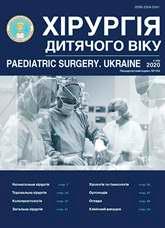VATS-resection of the lower lobe of the left lung as a result of treatment of the long-term consequences of postponed foreign body aspiration in the child’s airways: Clinical case
DOI:
https://doi.org/10.15574/PS.2020.69.90Keywords:
child, lungs, foreign bodyAbstract
Introduction. Foreign bodies in the airways are a very urgent problem that occurs at any age and quite often requires an urgent and sometimes urgent assessment of the situation, examination, and making the right decision. According to statistics, most often foreign body in airway are found in childhood. In about 95–98% of cases, this pathology is recorded in children aged 1.5 to 3 years. This is due to the behavior of children, their anatomical and physiological characteristics and underdevelopment of protective reflexes. Among all cases of foreign body in airway, foreign bodies of the larynx are found in 12%, trachea – in 18%, bronchus – in 70% of cases. In 80% of cases, CTs enter the right bronchus, as it is a broader and more direct continuation of the trachea. The correct diagnosis is established early after CT aspiration in 40–57% of patients. The mortality rate varies, according to different authors, from 2 to 15%.
Clinical case. The boy V., born in 2008. was admitted to the Department of Pediatric Pulmonology on May 30, 2019, with complaints of frequent unproductive cough, mainly daytime, increasing with physical exertion, sometimes subfibril body temperature, weakness, lethargy, decrease appetite. These complaints have been observed for the third time in the last six months. Diagnosis: Foreign body B10 of the left lung.
Conclusions. Aspiration of a foreign body into the respiratory tract most often occurs in early childhood (1–3 years). The clinical picture in the early stages is asymptomatic, and over time it leads to the development of inflammatory changes in the lungs, are treated conservatively. Given the complexity of diagnosis, aspiration of a foreign body can lead to frequent recurrent pneumonia, the formation of bronchiectasis in the lower parts of the lungs, which may require surgical treatment. The gold standard of diagnostics is fibrobronchoscopy and spiral computed tomography of the thoracic cavity (SCT OGK), with the help of which, early after aspiration, a foreign body can be detected and subsequently excluded from the respiratory tract.
The research was carried out in accordance with the principles of the Helsinki Declaration. The study protocol was approved by the Local Ethics Committee of an participating institution.The informed consent of the child’s parents was obtained from the studies.
References
Bogomilsky MR, Chistyakova VR. (2008). Diseases of the ear, nose and throat in children’s care: national guidelines. Moskow. GEOTAR – Media. 731 ISBN 978-5-9704-0847-6.
Grona VN. (2006). A course of lectures on pediatric surgery. Textbook. Donetsk. 282.
Morgan Jr. J. Edward, Magid S Mikhail M79. (2003). Clinical Anesthesiology: Book 3. Transl. from English: M. Publishing house BINOM. 304. Ill.
Order of the Ministry of Health of Ukraine. 28.09.2012. No.751. «Provision and implementation of medical and technological documents for standardization of medical aid in the systems of the Ministry of Health of Ukraine».
Order of the Ministry of Health of Ukraine. 06.27.2013. No.555. «About the consolidation and implementation of medical and technological documents for standardization of medical aid in chronic obstructive disease».
Vinogradov AV. (2012). Foreign bodies. http://www.littleone.ru/articles/more/zdorovieipsihologi/144
Downloads
Published
Issue
Section
License
The policy of the Journal “PAEDIATRIC SURGERY. UKRAINE” is compatible with the vast majority of funders' of open access and self-archiving policies. The journal provides immediate open access route being convinced that everyone – not only scientists - can benefit from research results, and publishes articles exclusively under open access distribution, with a Creative Commons Attribution-Noncommercial 4.0 international license(СС BY-NC).
Authors transfer the copyright to the Journal “PAEDIATRIC SURGERY.UKRAINE” when the manuscript is accepted for publication. Authors declare that this manuscript has not been published nor is under simultaneous consideration for publication elsewhere. After publication, the articles become freely available on-line to the public.
Readers have the right to use, distribute, and reproduce articles in any medium, provided the articles and the journal are properly cited.
The use of published materials for commercial purposes is strongly prohibited.

